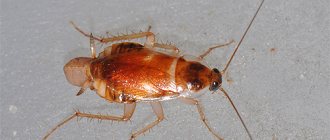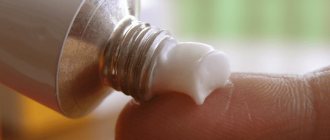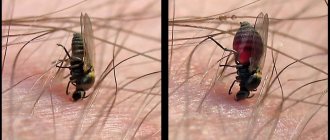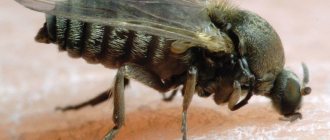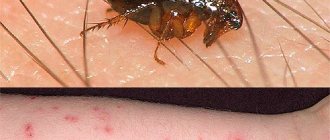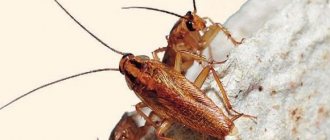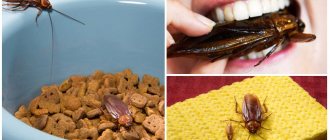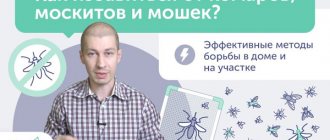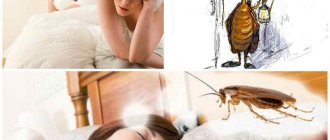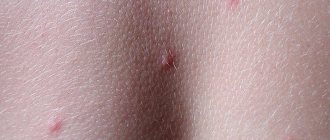For the common man, cockroaches are ordinary human companions who cause significant discomfort with their presence. However, biologists know more than 4.5 thousand species of these arthropods (55 in Russia).
In addition to hygienic harm, these arthropods pose a threat to health, not only indirectly, but also directly. In this article, the reader will learn about the dangers of a cockroach bite and what negative consequences it can have.
A hungry red cockroach can bite through human skin
Can cockroaches bite humans?
In the 60s of the last century, American scientists conducted a study to find out whether cockroaches bite under certain circumstances. During the study, it was discovered that longhorned beetles, due to their body structure (gnawing mouthparts and strong jaws), can bite people.
The special structure of the digestive apparatus allows insects to survive in conditions close to extreme. Prussians consume and process almost any food, including solid and seemingly unfit for consumption.
The digestive system of cockroaches successfully copes with paper, leather clothing and shoes, and soap.
Eyewitness stories about how at night cockroaches, emerging from their hiding places, attack sleeping people and leave inflamed wounds on the body that do not heal for a long time, are popular.
Video
20 interesting facts about COCKROACHS. You will be SHOCKED!
Can a cockroach get into your ear and how to get it out?
Quite often you can hear horror stories about cockroaches crawling into a person’s ear and causing terrible, unbearable pain. And these are not just horror stories. From time to time, doctors are faced with the fact that they have to remove dangerous insects from the ears. Often people themselves cannot get rid of the insect in the ear canal. A cockroach, once in a narrow place, cannot turn around and go back out. But this insect cannot walk backwards. As a result, a living cockroach moves its legs and whiskers, tries to get out of a narrow tunnel, constantly touches the eardrum, and this can cause:
- unbearable pain;
- dizziness;
- nausea;
- noise in ears;
- loss of consciousness.
If there is a person nearby who can help, then it is necessary to lay the victim on the bed with the ear, where the stuck cockroach sits, facing up. Then you should carefully pour warm water into the ear. It can push the insect out.
The second method of removing a Prussian from the auricle is to drip liquid oil into the ear canal - vegetable oil, olive oil, or any cosmetic oil without too strong a smell will do. When the oil blocks the insect's airways, it will suffocate. And then you can carefully remove the cockroach with tweezers. In this case, you need to pay attention to ensure that the individual is completely removed.
Sometimes a cockroach, if it has penetrated shallowly into the ear, can fall out on its own if you jump on one leg with your head tilted to the side.
You should not use a vacuum cleaner (yes, some craftsmen use it to remove a foreign body from the ear), use matches or cotton swabs - the situation can only worsen. Using these methods you can immerse the insect even deeper.
If there is no one nearby who can help you remove the cockroach from your ear, you need to contact an ENT doctor. If the pain becomes unbearable, you can call an ambulance - yes, sometimes the situation becomes very serious, especially when it comes to children.
What species bite
Many people are interested in whether cockroaches that appear in the house can bite a person and whether the ability of insects to be aggressive depends on the type of pest. Scientists say there is no direct relationship.
Any representative of the cockroach order can bite, especially if there is no access to food:
- The most common and often found in people's homes, Prussians bite if they are hungry or thirsty. Domestic cockroaches are more likely to bite at night, when humans pose the least danger. Longhorned beetles don’t just bite, they eat the skin around the mouth and eyes. Thus, cockroaches look for moisture remaining in food crumbs or accumulated in the lacrimal glands.
- Black representatives of longhorned beetles are dangerous during times of food and water shortage. In search of food, they, like their red relatives, can bite a person.
- The American cockroach, smaller in size compared to the Prussians, is also capable of harming humans. The consequences of a bite from an American longhorned beetle are worse than the consequences of damage to the skin by a red or black cockroach.
- Harmless-looking Egyptian pests also bite. Egyptian bites often cause severe allergic reactions.
Do cockroaches bite painfully?
The degree of pain from the bite depends on your level of pain tolerance. There is an interesting study that cockroaches can bite with a force 50 times stronger than its own body weight. Cockroaches mainly bite nails and eyelashes, which is why people do not perceive pain. Most people believe that cockroaches do not bite painfully; they only feel slight discomfort for a few seconds. Some people don't notice the bite at all until the itching begins.
In any case, you should not scratch the bite site. If cockroaches have bitten a child, it is better to apply anti-itch cream to the affected area so that he does not scratch it.
Treatment of the affected area
If you have marks from an insect bite on your body, before deciding what to do about the bite, you need to find out which insect caused the skin damage. Bedbugs, as a rule, leave characteristic marks in the form of an itchy, intensely itchy stripe.
This effect from a bedbug bite is observed as a result of the influence of special substances in the saliva of bedbugs on the body cells. Prussians leave small open wounds in places where human skin is most delicate.
If you know for sure that a person has been bitten by a cockroach, and the wound does not heal within one day, you need to consult a dermatologist. The doctor will examine the bite site and prescribe treatment appropriate to the problem.
If there is a strong local reaction, allergy sufferers must take an antihistamine.
Sometimes you can’t get an appointment with a doctor. Then traditional medicine methods become relevant. Fresh plantain or raw potatoes, ground to a mushy state, will relieve inflammation. Tea compresses have a similar effect.
First aid after bites
Patients often delay visiting a medical facility for one reason or another. It is important to know what emergency measures need to be taken if a cockroach bite occurs.
First of all, the wound must be disinfected. Hydrogen peroxide, chlorhexidine solution, or another alcohol-containing product are ideal. And an antihistamine taken on time will relieve severe itching after an insect bite.
It is not recommended to apply brilliant green solution to the affected area. Otherwise, the development of purulent processes is likely.
Zelenka complicates further examination of the bite site in order to identify hyperemia and an inflammatory process.
What to do if bitten by cockroaches
What steps should you take if you are bitten by cockroaches:
- If a cockroach bite is discovered in the morning and a characteristic crust has formed on the wound, nothing needs to be done. Just watch your condition.
- If the wound is open, it must be treated with hydrogen peroxide or a 70% alcohol solution. Then apply a bactericidal patch.
- If you have a minor allergic reaction or itching, you can use ointment for bites.
- If the allergic reaction is severe (hives, severe swelling, difficulty breathing), go to the hospital immediately.
In the first days after a cockroach bite, it is important to monitor your health. If you experience fever, nausea, diarrhea, or severe headaches, contact your nearest hospital.
We never tire of repeating that insect bites can cause irreparable harm to health, cockroaches are no exception. If you experience any unusual sensations after a bite, go to the hospital immediately. This is not an empty call, but a recommendation that can save lives. The hospital will take the necessary tests, conduct an examination, and make an accurate diagnosis. Modern medicine is well developed. You should not refuse qualified help and let the disease take its course.
The danger of cockroach bites
Human skin is a rather dense natural material, but the powerful jaws of the Prussian dog can seriously damage it. It has been proven that the bite force of a cockroach is more than 4 times stronger than that of a human.
It is easy to recognize traces of exposure to the skin of a barbel. Unlike blood-sucking insects, which leave behind only a puncture, or bedbugs, whose distinctive feature of contact with a person is a stripe of bites, the Prussian leaves behind a characteristic wound.
By morning, the damaged area, as a rule, has time to become covered with a crust, and around there is hyperemia of the skin, less often a blister, or swelling. Reactions are especially strong after the bite of “exotic”, American and Egyptian species.
The consequences of contact of the pest's mouthparts and saliva with human skin are not limited to small wounds, but are papular, purulent rashes accompanied by severe pain.
Local reactions of the body are not the only danger of contact with insects. A special protein, tropomyosin, found in barbel saliva can provoke a severe allergic reaction in people prone to allergies. So, after being bitten by a Germanic dog, many patients experienced hives, irritation, and sometimes suffocation.
Cockroaches are notorious for carrying various infections. When barbel saliva comes into contact with human blood, there is a risk of contracting serious infectious diseases, including dysentery and tuberculosis.
It is known that the presence of Prussians in the homes of some people can provoke asthma attacks.
Do cockroaches carry diseases?
Cockroaches can spread dangerous diseases. The World Health Organization states that cockroaches are carriers of several intestinal diseases such as dysentery, diarrhea, cholera and typhoid.
It is important to remember that cockroaches are omnivores; they feed on food when they crawl through sewers, drains, and garbage. They eat feces. Cockroaches crawl after “traveling” through your food, and this is where infection is possible. The same is true during a bite. Cockroaches can carry helminth eggs and can infect you. For people with allergies, cockroaches can cause swelling in the eyelid, dermatitis, itching and asthma.
Prevention of bites
Cockroaches are not just unpleasant neighbors, but also carriers of infections that can bite humans. We must try to prevent insects from appearing indoors.
For this it is enough:
- keep the house clean;
- store food in containers with walls inaccessible to damage by insects;
- eliminate stagnation of water in flowerpots;
- if necessary, treat the barbel penetration routes with special means.
If prevention does not help, cockroaches appear inside the house, it is better to contact a specialized company engaged in pest control of premises. Exterminators, using professional insect control products, will clear the house of uninvited guests quickly and effectively.
You can try to get rid of cockroaches yourself, using traditional methods of fighting barbels. The most popular is a solution based on boric acid, honey and sugar. Poisons sold in stores are effective - gels, aerosols (Raptor), special crayons, powders, smoke bombs.
How to prevent cockroach bites?
To get rid of cockroach bites forever, you need to destroy them, carry out insulation measures in houses (seal all the cracks, tear off loose wallpaper, install mesh ventilation).
If you are bitten by cockroaches, there is most likely a large infestation in the room and immediate action must be taken.
- There must be order at home
- Keep your house clean.
- There should be no dampness in the house.
- Wash dirty dishes immediately.
- Take out the trash every day.
- There should be no exposed food.
- Wipe the sink from water with a dry cloth.
- Cockroaches need food, water and warmth. Therefore, by depriving these benefits, the number of insects can be reduced.
Answers to popular questions
Longhorned beetles are insects whose appearance inside the house causes panic and fear. People often have a lot of questions about cockroaches and the dangers they pose. Below are the most popular questions from netizens regarding cockroach-like insects.
In what cases can a cockroach bite?
Longhorn beetles rarely bite. This is due to the fact that it is often not difficult for insects to provide themselves with food and water. In addition, cockroaches are able to survive without a food source for a month or more. But still, cases of bites are not isolated, so you should know why cockroaches can bite a person.
This only happens in the following cases:
- Acute food shortage. However, it is known that cockroaches are able to digest paper, leather goods, fabrics, and it is extremely rare to talk about this insect feeling hungry. However, during a long absence of a food source, Prussians can bite a person.
- Lack of water. But again, it is not difficult for a cockroach to quench its thirst. Condensation on the pipes, drops of water in the washbasin, wet soil in flowerpots, and this insect is the last person to go to as a source of moisture.
- A huge number of cockroaches inside the home. In such situations, the insect may go to other rooms in order to find food for itself, and the risk that the Prussian will crawl into bed with a sleeping person and bite him is great.
From the above it is clear that cockroaches prefer to avoid people. In modern houses, insects always have something to eat, and they don’t want to attack people at all.
What does a cockroach bite look like?
The consequences of contact between the jaws of a German and human skin depend on the type of insect.
- Black cockroaches leave serious damage. After contact with them, an allergic reaction is possible. The damaged area, as a rule, does not itch or bleed.
- The bite of red cockroaches leaves a small, uneven wound on a person, which after a while becomes covered with a crust. Sometimes in people prone to allergic reactions, the bite site becomes inflamed and red, but itching, as a rule, is not observed.
- Regarding the American relative of the Prussians, contact with this type of insect can provoke not only a small wound, but also a rash in the area of skin damage, the appearance of blisters and ulcers. The bite site may be very painful.
How do cockroaches bite?
Insects eat almost everything thanks to their powerful oral apparatus: Prussians have strong sickle-shaped jaws with jagged teeth, with chitinous teeth located in them, with which cockroaches bite.
In the absence of normal food, paper, leather goods and other materials become suitable for consumption. Human skin is no exception. By acting on it with jowls with teeth. A cockroach pinches off pieces of human dermis.
If there is a shortage of food, it will not be difficult for the pest to gnaw human skin.
The place from the bite looks exactly gnawed, and not, for example, pierced.
What to do with cockroaches in an apartment?
There are many anti-cockroach products on the market today. I won’t describe each one; this is a topic for a separate article. It is important to remember one thing - if the number of cockroaches in an apartment has increased to impressive sizes, the best thing that can be done is to call the sanitary and epidemiological service. This is not an advertisement, this is a recommendation.
Complete treatment of residential premises with professional insecticides will help cope with the problem. Independent control of cockroaches is relevant only if the colony size is small. In other cases, you should seek help from specialists.
Post Views: 837
Prevention and prevention of cockroaches
- Regular removal of garbage from the apartment (preferably daily);
- All food products must be refrigerated;
- Cleaning surfaces after preparing or eating food;
- Minor repairs to the premises: sealing cracks near risers, windows, pipes, in the door area; sealing gaps, grooves and cracks in walls;
- Thorough cleaning and washing of places where cockroaches were found;
- Water taps should be turned off at night, and bathtubs and washbasins should be kept dry.
In case of infection, the first step is to remove all food from the cupboards and into the refrigerator. Then check the possible habitats: in the evening and at night, examine cracks, cracks in heated places near water sources - sinks, bathtubs - the space under electrical appliances, near electric motors, behind electrical panels, near electrical wiring, on the back wall and under the refrigerator (in motors). and rubber gaskets), under gas stoves, behind cabinets and shelves, behind heating radiators (in winter), under cooking boilers and behind their casing, under dishwashers, bathtubs and other equipment; inspect the hollow legs of cutting tables, bedside tables, table drawers, door frames, and wardrobes. In case of severe infection, even the computer system unit.
When can they bite?
Even knowing about such possibilities of insects, many people continue to doubt that a cockroach can bite them.
The reason for this doubt is that people almost never see how cockroaches bite.
After all, all bites occur only at night. The time that people spend sleeping is the period of maximum activity for cockroaches.
This is understandable: cockroaches are cautious and rather timid insects. They know well that a waking person is a serious danger to them.
Therefore, they quickly and swiftly run away when meeting people. But a sleeping person is not dangerous for them.
There are several reasons why cockroaches may move from the kitchen to the bedroom.
How to treat?
In most cases, cockroach bites can be treated using home remedies. There is no particular need to seek medical help (in the absence of complications). If damage to the skin is detected, you should:
- treat wounds with antiseptic solutions, for example, hydrogen peroxide;
- apply an ointment to relieve skin inflammation, for example, Rescue balm or Fenistil gel;
- You can use folk remedies, for example, compresses from grated potatoes, crumpled plantain leaves or white cabbage.
Advice! It is important not to confuse the “authorship” of the bites. Prussians extremely rarely bite people, so the appearance of wounds may be a consequence of the presence of bedbugs or fleas in the house.
